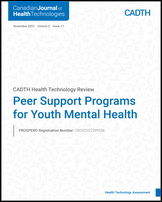|
Self-efficacy about disclosing mental illness
| Conley et al. (2020)39 and Hundert et al. (2021)40 (associated) | Results of all participants (n analyzed = 117 at baseline [T0]), 107 at post-intervention [T1], 97 at post-booster [T2])39 Self-efficacy about disclosing mental illness, mean (SD) at T0 vs. T1 vs. T2 (single item score): HOP-C = 4.35 (1.68) vs. 5.22 (1.03) vs. 5.87 (1.11) Control = 4.33 (1.60) vs. 4.60 (1.55) vs.4.79 (1.56) Group x Time ANOVA for T1-T2-T3, p = 0.001; T1-T2, p = 0.078; T1-T3, p = 0.001
Self-efficacy in keeping mental illness a secret, mean (SD) at T0 vs. T1 vs. T2 (single item score):HOP-C = 4.63 (1.58) vs. 5.15 (1.26) vs. 5.41 (1.29) Control = 4.48 (1.64) vs. 4.65 (1.63) vs. 5.04 (1.44) Group x Time ANOVA for T1-T2-T3, p = 0.590
Results of the 2-month follow-up analysis in a population subset from 1 university (n analyzed = 55 at all timepoints; baseline [T0], post-intervention [T1], 2 months follow-up [T4])40Self-efficacy about disclosing mental illness, mean (SD) at T0 vs. T1 vs. T3 (single item score): HOP-C = 4.33 (1.74) vs. 5.42 (1.02) vs. 5.38 (1.35) Control = 4.71 (1.58) vs. 5.07 (1.49) vs. 5.21 (1.23) Group x Time ANOVA for T0-T1-T3, p = 0.230
Self-efficacy in keeping mental illness a secret, mean (SD) at T0 vs. T1 vs. T3 (single item score):HOP-C = 4.83 (1.61) vs. 5.33 (1.17) vs 5.38 (1.35) Control group = 4.32 (1.68) vs. 4.86 (1.60) vs. 4.93 (1.33) Group x Time ANOVA for T0-T1-T3, p = 0.926
|
|
Attitudes to disclosure (family, friends, and teacher employer)
| Mulfinger et al. (2018)50 | Results of all participants (n analyzed = 98 at baseline [T0], 84 at post-intervention [T1], 62 at follow-up [T2])50 Between-group ITT analyses were conducted using linear MMRM. Attitudes to Disclosure (Family/Friends) – single item, mean (SD) at T0 vs. T1 vs. T2: HOP = 3.10 (1.62) vs. 4.21 (1.40) vs 4.13 (1.44) Control = 2.83 (1.59) vs. 3.00 (1.61) vs. 2.82 (1.56) Mean between-group difference (95% CI) for change from T0 to T1 = 1.00 (0.43 to 1.57), p<0.001 Mean between-group difference (95% CI) for change from T0 to T2 = 1.02 (0.43 to 1.61), p = 0.001
Attitudes to Disclosure (Teacher/Employer) – single item, mean (SD) at T0 vs. T1 vs. T2:HOP = 2.00 (1.24) vs. 2.60 (1.33) vs 2.86 (1.52) Control = 2.27 (1.58) vs. 2.00 (1.13) vs. 1.95 (1.25) Mean between-group difference (95% CI) for change from T0 to T1 = 0.66 (0.15 to 1.16), p = 0.011 Mean between-group difference (95% CI) for change from T0 to T2 = 0.91 (0.28 to 1.53), p = 0.005
|
|
Disclosure-related distress (single item)
| Mulfinger et al. (2018)50 | Results of all participants (n analyzed = 98 at baseline [T0], 84 at post-intervention [T1], 62 at follow-up [T2])50 Between-group ITT analyses were conducted using linear MMRM. Disclosure-related distress, mean (SD) at T0 vs. T1 vs. T2 (single item score): HOP = 4.70 (1.65) vs. 3.92 (1.20) vs. 3.43 (1.53) Control = 4.61 (1.68) vs. 4.78 (1.44) vs. 4.74 (1.41) Mean between-group difference (95% CI) for change from T0 to T1 = –0.87 (–1.37 to –0.37), p<0.001 Mean between-group difference (95% CI) for change from T0 to T2 = –1.18 (–1.85 to –0.51), p<0.001
|
|
Secrecy
| Mulfinger et al. (2018)50 | Results of all participants (n analyzed = 98 at baseline [T0], 84 at post-intervention [T1], 62 at follow-up [T2])50 Between-group ITT analyses were conducted using linear MMRM. Stigma Coping Orientation Scale, mean (SD) at T0 vs. T1 vs. T2: HOP = 3.74 (0.83) vs. 3.31 (0.85) vs. 3.15 (0.96) Control = 3.78 (1.09) vs. 3.86 (1.12) vs. 4.01 (1.02) Mean between-group difference (95% CI) for change from T0 to T1 = –0.44(–0.79 to –0.08), p =0.017
Mean between-group difference (95% CI) for change from T0 to T2 = –0.78 (–1.16 to –0.40), p<0.001 |
